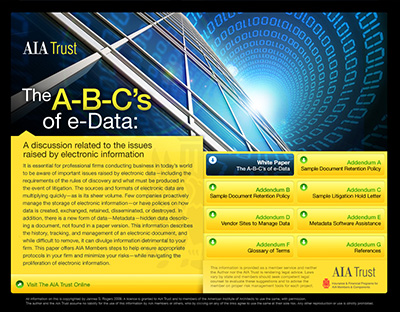By Insurance Buyers Council, Inc. Since 1948, Insurance Buyers’ Council, Inc. (IBC) has a mission to provide their clients with unbiased information. IBC is not affiliated with companies that sell insurance to assure that the information they provide is completely unbiased; they do not benefit financially from any insurance recommendations. Combined, IBC’s staff possesses over…
Read MoreTopic: Professional liability
Four Keys to a Successful Condominium Project
Condominium work for developers, construction managers, contractors, and design firms continues to be strong after being scarce following the 2008 economic collapse. Many millennials and other first time buyers can and want to invest in condo units in urban areas. And renting is less attractive to a maturing class of residential market participants as they…
Read MoreVirtual Practice Made Real
The AIA Trust Guide to Virtual Practice, is a treasure-trove of invaluable pointers and considerations for this burgeoning approach to architectural practice. The guide offers an overview of requirements and questions to consider when starting or working in a virtual practice. For example, what actually is a virtual practice and how does it differ from…
Read MoreDesigning for Hedonism: Guide to Marijuana Facilities Design
While the production and retail sale of alcohol has a long history in the United States, the same cannot be said for the marijuana industry, which is much newer and struggling with growing pains. It is also handicapped by the Federal government’s position that it is illegal–along with conflicting legal requirements by different states. In…
Read MoreAn Architect’s Guide to Virtual Practice
Today, a new reality in architectural practice is that most architects are no longer interacting across their workstations. Instead, they are ‘virtually’ sharing ideas and drawings across digital platforms. Nearly every practicing architect engages in some form of “virtual practice” because the pace and practicalities of life demand it–employees travel or relocate, must limit work…
Read MoreBusiness Coverage Professional Liability
Quick Risk Review
As a risk management resource for AIA Members, the AIA Trust develops risk reports on topics of critical and evolving risks for architects. If you don’t have time to read the risk reports, new synopses give you the important facts. Check them out now—so you stay out in front of critical risks. Some of these…
Read MoreUnderstanding the Standard of Care
Published by AIA’s Risk Management Committee (RMC), below are two articles to explain how the standard of care applies to your practice. Often the actions of the architect are measured against the applicable “standard of care.” Perfection is not the standard of care for the practice of architecture and while the common law standard of…
Read MoreHow Independent Reviews Help Manage Firm Exposure
The likelihood of design deliverables being released for approval or actual construction while containing negligent errors or omissions are higher than most firms would like. This is due to projects becoming more complex and design times being severely constrained. As such, more projects are involving design input from a wide range of consultants and other…
Read MoreQuick Reference: Risk Resource Review
As a risk management resource for AIA Members, the AIA Trust develops risk reports on topics of critical and evolving risks for architects. Some of these risks you may be aware of—and some may never have crossed your mind. Either way, it’s important to be able to recognize them so you can at best avoid…
Read MoreDiscovering Your Electronic Data
As the law pertaining to electronic data evolves, architecture firms must understand the issues around it. Firms must be able to identify the electronic data involved in their daily operations and how to properly store and discard it. Importantly, as electronic data grows exponentially, firms must also understand rules of discovery requirements and what one…
Read More